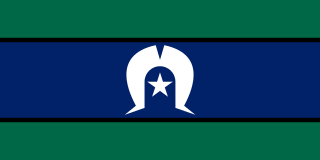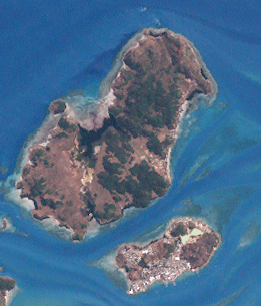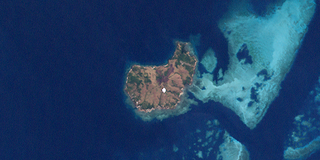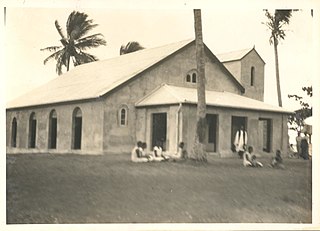
The Torres Strait, also known as Zenadh Kes, is a strait between Australia and the Melanesian island of New Guinea. It is 150 km (93 mi) wide at its narrowest extent. To the south is Cape York Peninsula, the northernmost extremity of the Australian mainland. To the north is the Western Province of Papua New Guinea. It is named after the Spanish navigator Luís Vaz de Torres, who sailed through the strait in 1606.

The Torres Strait Islands are an archipelago of at least 274 small islands in the Torres Strait, a waterway separating far northern continental Australia's Cape York Peninsula and the island of New Guinea. They span an area of 48,000 km2 (19,000 sq mi), but their total land area is 566 km2 (219 sq mi).

Torres Strait Islanders are the Indigenous Melanesian people of the Torres Strait Islands, which are part of the state of Queensland, Australia. Ethnically distinct from the Aboriginal peoples of the rest of Australia, they are often grouped with them as Indigenous Australians. Today, there are many more Torres Strait Islander people living in mainland Australia than on the Islands.
The Mabuyag are an Indigenous Australian group of Torres Strait Islander people united by a common language, strong ties of kinship and survived as skilled hunter–fisher–gatherers and horticulturalists in family groups or clans living on and around Mabuiag Island, in Torres Strait in Queensland, Australia. They are ethnically Melanesian.

Mabuiag, also known as "Mabuyag" and natively "Mabuyaagi", formerly "Jervis Island") is one of the Torres Strait Islands in Queensland, Australia. Mabuiag is also a town and locality in the Torres Strait Island Region local government area. In the 2021 census, the locality of Mabuiag Island had a population of 253 people.

Saibai Island, commonly called Saibai, is an island of the Torres Strait Islands archipelago, located in the Torres Strait of Queensland, Australia. The island is situated north of the Australian mainland and south of the island of New Guinea. The island is a locality within the Torres Strait Island Region local government area. The town of Saibai is located on the north-west coast of the island.

Seisia is a coastal town and a locality in the Northern Peninsula Area Region, Queensland, Australia. In the 2021 census, the locality of Seisia had a population of 293 people.

Hammond Island is an island with a town of the same name, in the Torres Strait, Queensland, Australia. It is the only island within the locality of Keriri Island within the local government area of Torres Strait Island Region. In the 2021 census, Hammond Island had a population of 261 people, of whom 253 (96.9%) identified as Indigenous Australians.

Sue Islet, also known as Warraber, is the middle islet of The Three Sisters, Torres Strait, Queensland, Australia. This island is one of the Torres Strait Islands and is within the locality of Warraber Islet in the Torres Strait Island Region.

Badu or Badu Island, is an island in the Torres Strait 60 kilometres (37 mi) north of Thursday Island, Queensland, Australia. Badu Island is also a locality in the Torres Strait Island Region, and Wakaid is the only town, located on the south-east coast. This island is one of the Torres Strait Islands. The language of Badu is Kala Lagaw Ya.

Coconut Island, Poruma Island, or Puruma in the local language, is an island in the Great North East Channel near Cumberland Passage, Torres Strait, Queensland, Australia. One of the Torres Strait Islands, Coconut Island is 130 kilometres (81 mi) northeast of Thursday Island. Administratively, Coconut Island is a town and Poruma Island is the locality within the Shire of Torres.

Yam Island, called Yama or Iama in the Kulkalgau Ya language or Turtle-backed Island in English, is an island of the Bourke Isles group of the Torres Strait Islands, located in the Tancred Passage of the Torres Strait in Queensland, Australia. The island is situated approximately 100 kilometres (62 mi) northeast of Thursday Island and measures about 2 square kilometres (0.77 sq mi). The island is an official locality known as Iama Island within the local government area of Torres Strait Island Region. The town, also called Yam Island, is located on the north-west coast of the island. In the 2021 census, Iama Island had a population of 275 people.

Darnley Island or Erub in the native Papuan language, Meriam Mir, is an island formed by volcanic action and situated in the eastern section of the Torres Strait, Queensland, Australia. It is one of the Torres Strait Islands and is located near the Great Barrier Reef and just south of the Bligh entrance. The town on the island is also called Darnley, but the locality is called Erub Island, both being within the local government area of Torres Strait Island Region. In the 2021 census, Erub Island had a population of 326 people, with 292 (89.6%) identifying as Indigenous Australians.

Talbot Islands are a group of Torres Strait Islands in Queensland, Australia. They lie between the Australian mainland and the island of New Guinea and a few kilometres west of Saibai Island, Torres Strait, only 4 km from the Papua New Guinea mainland at the mouth of the Mai Kussa River.
The Torres Strait Island Region is a local government area in Far North Queensland, Australia, covering part of the Torres Strait Islands. It was created in March 2008 out of 15 autonomous Island Councils during a period of statewide local government reform. It has offices in each of its 15 communities, and satellite services in Thursday Island and in Cairns.

Holy Trinity Church is a heritage-listed Anglican church at Saibai Island, Torres Strait Island Region, Queensland, Australia. It was built from 1917 to 1938. It is also known as Holy Trinity Church of England. It was added to the Queensland Heritage Register on 21 October 1992.

Dauan Island is an island in the Torres Strait, Queensland, Australia; it is also known as Cornwallis Island. Dauan Island is also a town and locality in the Torres Strait Island Region, Queensland, Australia. In the 2021 census, the locality of Dauan Island had a population of 131 people.

Masig Island is an island and locality in the Torres Strait Island Region, Queensland, Australia. In the 2021 census, Masig Island had a population of 283 people.
Saibai is a town within the locality of Saibai Island in the Torres Strait Island Region, Queensland, Australia. In the 2021 census, the town of Saibai had a population of 340 people.
The Torres Strait Treaty is a treaty signed between Australia and Papua New Guinea. The treaty defined the border between Australia and Papua New Guinea following the latter's independence from Australia in 1975. The treaty also set out the manner in which the common border area would be managed. The treaty was signed in December 1978 and came into effect in 1985.



















